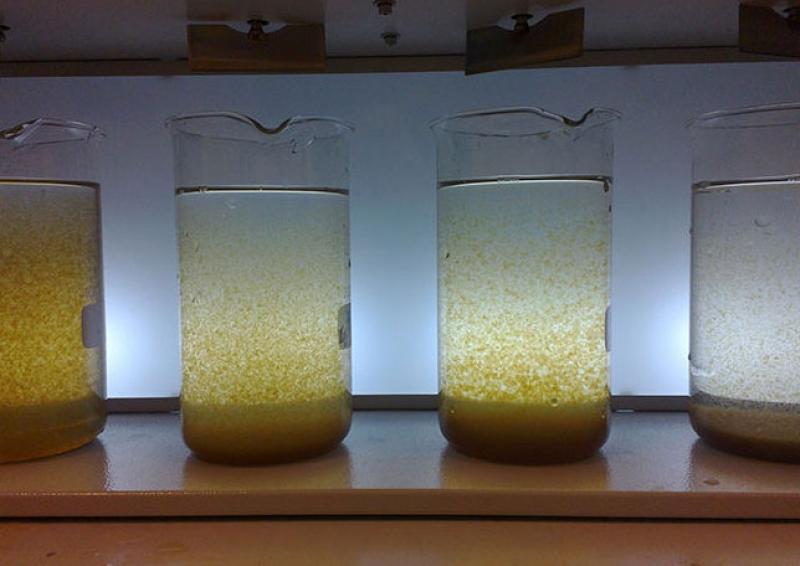Flocculants and Coagulants are two important processes that are commonly employed in water and wastewater treatment. Both the processes involve the addition of particular chemicals to remove suspended solid particles from water or wastewater.
What is Flocculation?
Flocculation refers to the process where Flocculant and Coagulants are added to water or wastewater containing dispersed solid particles. Flocculants are polymers that promote the clumping of fine suspended particles in water to form larger, easily settleable clumps or flocs. The addition of flocculants induces inter-particle bridging where particles collide and stick together via van der Waals forces to form flocs. Common synthetic flocculants used include polyacrylamide, polyamine and epichlorohydrin. The formation of flocs reduces the total surface area of suspended particles and makes them settle faster under gravity in a sedimentation basin. This clarifies the treated water.
Factors Affecting Flocculation Process
Several factors influence the efficiency of flocculation such as the dosage and type of flocculant used, mixing intensity, pH and temperature of water, surface properties and concentrations of particles. The flocculation process is optimised by controlling these factors. Inadequate mixing can lead to partial flocculation whereas too vigorous mixing may cause floc breakdown. The optimum pH range is one where particles attain maximum surface charge for efficient interaction with oppositely charged flocculant molecules.
What is Coagulation?
Coagulation involves the addition of metal salt coagulants like alums (aluminum sulfate), iron salts (ferric chloride, ferrous sulfate) or polymers to treated water. Coagulants neutralize or reduce the surface charge of suspended solid particles causing them to collide and cling together. This initiates the coagulation process where microflocs start forming. The microflocs formed serve as sites for adsorption of charged polymer chains of flocculants to bridge between particle collisions and form larger flocs.
Mechanism of Flocculants and Coagulants
Upon addition to water, metal salt coagulants like aluminum sulfate and ferric chloride hydrolyze to form monomeric positive aluminum 3+ or ferric 3+ species which polymerize further to form polymeric aluminum or ferric hydrolysis products. These positively charged polycationic species adsorb onto negatively charged solid surfaces by electrostatic attraction and neutralize the surface charge. The surface charge neutralization causes destabilization of particle suspensions leading to inter-particle collision and aggregation. The bridging and sweep-floc mechanisms additionally help in floc formation during coagulation.
Factors Influencing Coagulation
The dosage and type of metal salt coagulant used, pH, alkalinity and temperature of water affects coagulation. At optimum pH, metal hydrolysis products are most positively charged to effectively neutralize particle surfaces. Low turbidity waters require higher coagulant dosages for effective coagulation. Low alkalinity waters need pH adjustment by alkali addition to boost metal hydrolysis. Higher temperatures increase rates of particle collisions speeding up coagulation.
Significance and Applications
Flocculants and coagulants find wide application in municipal and industrial water treatment plants for removal of suspended solids, turbidity, natural organic matter, pathogens, heavy metals and other contaminants. They provide an effective pre-treatment step prior to filtration or other polishing processes. Coagulated and flocculated solids are removed by sedimentation while the clarified treated water is disinfected and supplied for various end uses. These processes have helped worldwide in conserving freshwater resources and maintaining water quality.
Water Treatment Plant Design Considerations
The design of flocculants and coagulants treatment units factor in parameters like raw water quality, desired treated water quality and flow rates. Sedimentation basins are sized according to surface overflow rates and detention times required for effective settling of flocs. Mechanically agitated flocculators have adjustable paddles and multiple chambers for control of flocculation mixing conditions. Coagulant feed systems meter coagulants based on flow. Baffles, inlet-outlet arrangements help in hydraulic optimization. Proper operation and maintenance involve monitoring of process parameters and influent-effluent water quality. Automation facilitates better process control.
Future Prospects and Research Areas
While coagulation-flocculation holds prominence in water treatment even today, ongoing research strives to develop improved coagulant materials, optimized structures for treatment units and advanced process control techniques. Areas of active research include development and evaluation of novel inorganic and organic coagulant aids, bio-based polymers as eco-friendly flocculants, nanomaterial applications, advanced membrane technologies as an alternative, optimization of treatment schemes through modeling and artificial intelligence. Overall, constant innovation aims at enhancing process efficiencies, minimizing residuals generation and upgrading existing facilities to meet more stringent quality standards.
In summary, flocculants and coagulants remain cornerstone water treatment processes harnessing the principles of colloid and surface chemistry. Advancements through multidisciplinary research further the goal of universal access to safe and affordable drinking water resources. Proper understanding and application of these processes continue to play a key role in serving communities worldwide.
For Deeper Insights, Find the Report in the Language that You want:
About Author:
Alice Mutum is a seasoned senior content editor at Coherent Market Insights, leveraging extensive expertise gained from her previous role as a content writer. With seven years in content development, Alice masterfully employs SEO best practices and cutting-edge digital marketing strategies to craft high-ranking, impactful content. As an editor, she meticulously ensures flawless grammar and punctuation, precise data accuracy, and perfect alignment with audience needs in every research report. Alice's dedication to excellence and her strategic approach to content make her an invaluable asset in the world of market insights.
(LinkedIn: www.linkedin.com/in/alice-mutum-3b247b137 )
